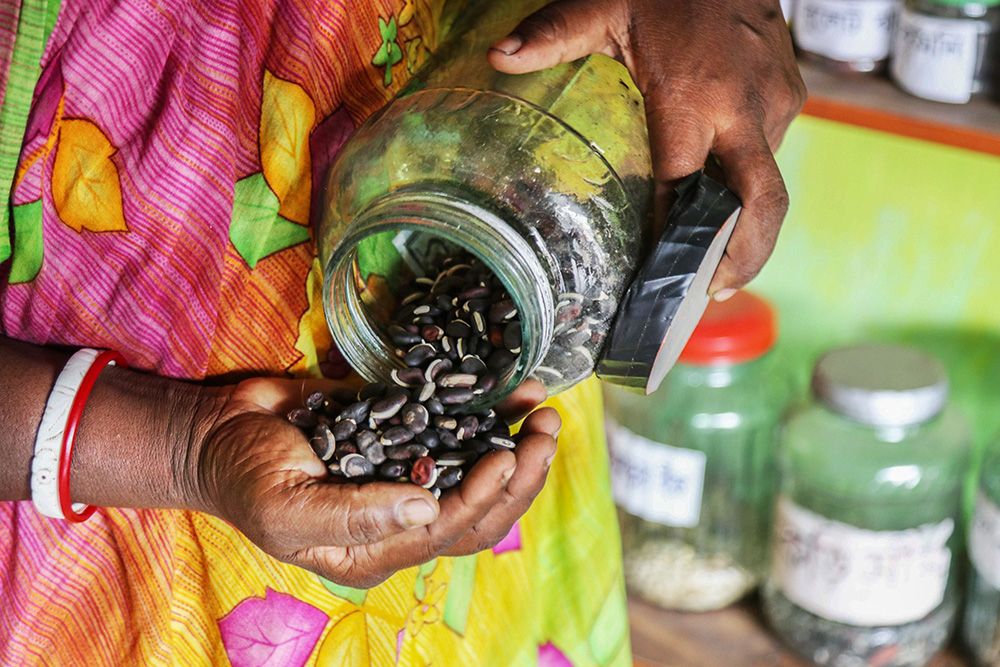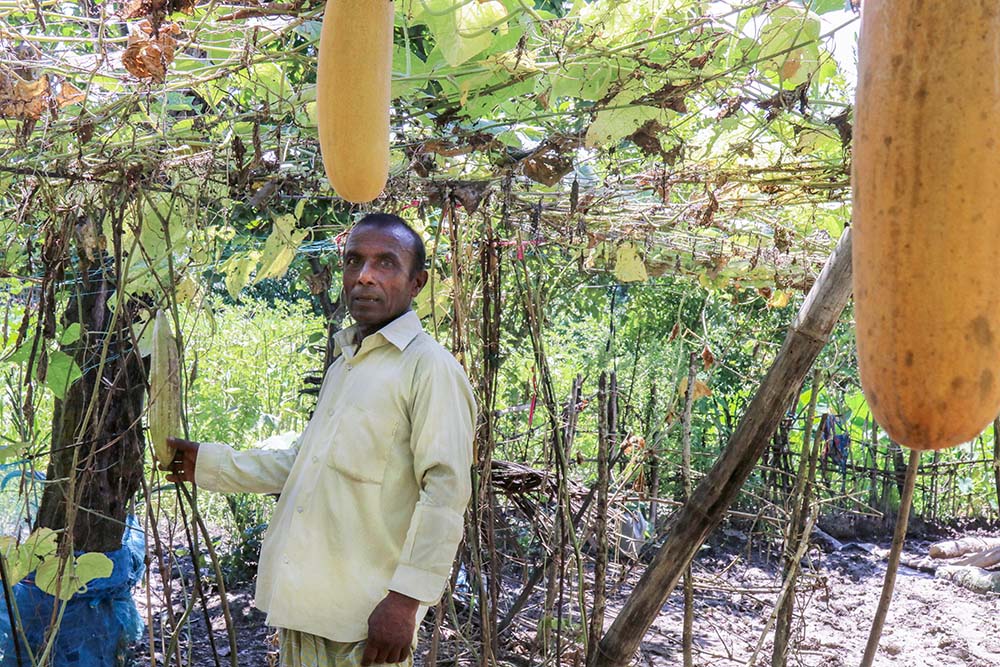
Alpana Rani Mistry often gives indigenous seeds to her neighbors and sends seeds to other parts of the country. (Stephan Uttom Rozario)
In the courtyard of the house of Ganesh Chandra Mandal, there is little open space anywhere, but there are vegetables planted everywhere.
For years, Mandal, 65, has grown indigenous vegetables — okra, corn, cucumber, carrots, beets, turnips, onions, ridged gourd and teasel gourd — in all parts of his 1.25-hectare (3-acre) house and 2.51-hectare (6.2-acre) paddy land.
All are native species grown without the use of chemical fertilizers or pesticides, and each crop started from seeds he saved and planted.
"I have planted the saplings of [persimmon] seed by eating the palm," Mandal told EarthBeat. "I am eating the fruits from the saplings of the custard apple, which have grown into trees. I buy pomegranates and keep the seeds from them, and from [those] seeds also grow trees and now I eat the fruits."
For Mandal and his three sons, collecting indigenous seeds and cultivating native crops is their profession and means of providing for the family of seven living in the Shyamnagar area of Satkhira district along Bangladesh's southern coast. In the market, they sell both crops and seeds of indigenous species. Mandal also gives some seeds to his neighbors for free.

Ganesh Chandra Mandal shows indigenous varieties of cucumbers from which he has earned a substantial income. (Stephan Uttom Rozario)
The at-home farmer learned seed conservation 18 years ago through a training program of Caritas Bangladesh.
"We came and tried it at home and that's how we got hooked on growing these indigenous species," Mandal said.
Since the 1990s, the Catholic development organization has worked in Bangladesh's coastal areas to improve the livelihoods of low-income people. A decade later, it started encouraging cultivation of indigenous crops alongside projects responding and adapting to weather-related disasters.
In 2014, Caritas began an extensive training and public relations program on agriculture. It has promoted ways for farmers to identify and save indigenous seeds as well as natural methods for successfully cultivating them, such as using wood ash as a nature-based pesticide.
The goal is to improve native crop farming capacity and knowledge within villages, said Suman Malaker, a senior officer of Caritas Bangladesh in the coastal Khulna region.
"We looked at the conservation of indigenous varieties so that at the farmer level the seeds of these indigenous species can be saved," he told EarthBeat.
Indigenous seeds have an advantage over high-yielding alternatives that are for sale in the market, the latter being more prone to insect infestation and have higher costs to protect them.
As Bangladesh's population has increased, so has the demand for food, said Malaker, who holds a doctorate in agriculture. To increase production, large-scale growers have turned more to hybrid seeds, while the old indigenous seeds have become less available and less appealing.
Advertisement
For Mandal, who currently conserves around 1,600 species of indigenous seeds for various crop types, he's seen a limited market for his older seeds. Many have been wasted.
Hybrid farming requires large amounts of pesticides and chemical fertilizers, which can pose health risks for both people and ecosystems, Malaker said. The use of synthetic products also adds to the costs of growing hybrid seeds; in cases like rice, an indigenous variety can be more profitable even though it produces slightly lower yields. Hybrid crops tend to have lower disease resistance than indigenous counterparts, which also have a higher salt tolerance — an important trait in parts of Bangladesh where sea levels are rising.
Malaker said that while indigenous crops can be more profitable, their low production rate makes it difficult to grow them at commercial scale.
But by planting native varieties of crops, herbs and vegetables in courtyards or around homes, families can meet their needs and those of the surrounding community, the Caritas official said. That in turn could reduce market demand for high-yielding crops, and with it reduce the use of fertilizers and chemicals and limit environmental damage.

Agriculturalist and researcher Suman Malaker is a senior officer of Caritas Bangladesh in the coastal Khulna region. (Stephan Uttom Rozario)
"If all the families plant the seeds of these native species to meet their family needs, then there will be an overall benefit," he told EarthBeat.
Five kilometers away from Mandal's seed-stuffed house lives Alpana Rani Mistry. She has about 400 species of different crop seeds herself and 160 species of indigenous rice seeds in reserve. Mistry cultivates them on her land and distributes them free of cost to people in different parts of the country.
"When we plant local seeds, we don't have to use any chemical fertilizers, we always use organic fertilizers. We get fruits from local varieties of seeds for a long time," said the 45-year-old Mistry, who also underwent native crop training with Caritas Bangladesh.
In contrast to hybrid plants, whose seeds can't be saved, the indigenous varieties that Mistry plants can be collected and kept. In addition to seeds, she raises ducks, chickens, cows and goats at her house and makes compost with their droppings. Along with wood ash, she makes natural insect repellent from the water remaining after boiling mahogany fruit and neem leaves.
While growing indigenous species at large scale is not widespread, demand for indigenous crops and organically grown crops has increased in Bangladesh for health reasons.

Alpana Rani Mistry shows her seed bank, about 400 species of different crop seeds and 160 species of indigenous rice seeds in reserve. (Stephan Uttom Rozario)
The limited supply has led to high prices for organic and local vegetables sold directly in the market or online. Mistry says the price of organic native vegetables and indigenous species of crops is at least 20 taka (about 17 cents) more per kilogram than the price of farm crops in the market. The higher prices have also resulted in people seeking out hybrid crops produced in greater quantities and at faster rates.
There are many challenges to cultivating indigenous crops, Malaker said.
In coastal areas, weather-related disasters can soak fields and wipe out crops, with such storms becoming stronger due to climate change. Staff shortages in the government's agriculture department also present a major challenge. In addition, small-scale farmers often lack tracking in modern techniques.
The Caritas official believes that establishing agricultural advisory centers in more areas would allow more people to grow seeds of native species, providing more communities with safer food for consumption while also better protecting the environment.
In the meantime, at-home farmers like Mandal and Mistry continue to save and cultivate seeds of indigenous species with the assistance of nongovernmental organizations like Caritas and some government programs. But they say greater government assistance is necessary for large-scale and commercial cultivation to flourish.
"I am saving the seeds of indigenous species in my way," Mandal said, "but if the government or NGOs like Caritas would have helped me more, I would have saved and marketed the seeds commercially."








